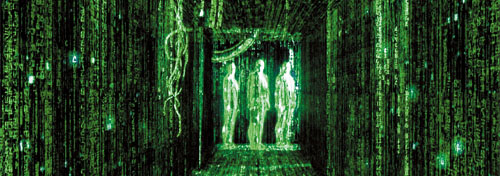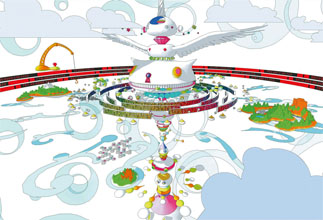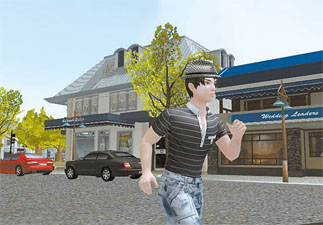Welcome to a new reality

A scene from the hit film “The Matrix.”
Part of the buzz is tied to the fact that the movie features the latest in three-dimensional technology, offering a realistic experience that has viewers believing they are actually part of the film. But audiences are just as interested in the story itself, which takes place in a world where people can transfer their souls and minds to avatars - or puppet-like bodies. In the movie, the main character, an ex-marine named Jake who is paralyzed from the waist down, is able to walk again by inhabiting his avatar body, to which his consciousness is linked.
The Japanese animation “Summer Wars,” which was released this past summer, explores a similar concept, detailing what happens when a virtual world called OZ collides with the real world.
In the movie, people can connect to OZ with devices like cell phones, where they can do everything from shop and meet with friends to pay their bills through their avatars.
But filmmakers aren’t the only ones taking an interest in virtual worlds.
A number of global companies and governments around the world are focusing on them as well, viewing these alternate realities as a way to boost profits and lure new customers in the digital age.
And they’re putting their money where their collective mouth is, pumping roughly $600 million into developing content for virtual worlds last year, according to a study by U.S.-based media research company Engage Digital.
Korea hasn’t made much headway in this area, but that’s beginning to change as the government and companies dip their toes into virtual worlds. The goal is to tap a potentially huge new market and provide services and information to people in an entirely new format. But it remains unclear if these worlds will catch on with Koreans, as previous efforts have been met with limited success.
Ideal place for humans
While there is plenty of skepticism about whether virtual worlds will actually ever really catch on in the mainstream, many observers think that they will at least play a role in the daily lives of people at some point. Numerous experts argue that virtual worlds are an ideal place for humans, who always try to challenge the limitations of reality.
“Virtual worlds will bring about a revolution in our lives just as the Internet did,” said Park Soo-yeon, a senior researcher at the Korea Creative Content Agency. “Aside from their importance from an industrial and economic perspective, they are likely to be the nucleus of societal, cultural and political changes around the world.”
Currently there are about 100 Web sites with virtual worlds globally. The most vigorous region in terms of development in this realm is the United States.
“Second Life,” a 3-D virtual world where users actively participate in creating content based on technology provided by Linden Lab, was a huge hit internationally and spawned numerous other virtual worlds like “Vivaty” and “IMVU.”
As its name suggests, the technology aims to give users a “second life” via avatars in a virtual world. Many global companies are making good use of Second Life, utilizing it as a way to collect data about consumers, test products and create new businesses. Some sell goods and services for use only in the virtual realm - such as prime real estate for building a digital house - while others advertise products for use in the real world.
A second stab
Korea boasts well-known online games such as “Lineage,” but the concept of virtual worlds hasn’t taken off here to date.
Even Second Life, which entered the Korean market in 2007, recently withdrew from the country last month due to lackluster performance. It’s somewhat surprising, given the nation’s technological prowess.

In OZ, a virtual world depicted in the Japanese animation “Summer Wars,” people can connect to the cyber realm with devices like cell phones and act as they do in the real world through their avatars.Right:“C2Town,” the Korean version of the hit U.S. virtual world “Second Life” to be released soon, will closely resemble the real world.
But local firms are taking another stab at developing this nascent market.
Hi-NG Corporation, a local 3-D computer graphic development company, is currently working on developing an online community called “Azitro,” a virtual space intended for women in their 20s.
“We will create a 3-D version of places mostly visited by 20-something women around Seoul, such as the Hongik University area, Daehangno and Cheongdam-dong,” said Park Young-woon, chief executive of the company. “Then users can create their own space in the virtual world to build a house with a garden of their design.”
Park, who studied electronics engineering in college and worked in a major company’s research institute for about 10 years, established Hi-NG Corporation in 2003 jointly with his three friends. Park said that he was attracted to the concept of virtual worlds after seeing the hit 1999 movie “The Matrix.” He built his business to provide people with a unique cyberspace experience. The company tested Azitro last year and will officially launch the service next month.
Though Second Life failed to establish a presence in Korea, Tri-d Communications - a local 3-D content developer - is striving to create a Korean version of the virtual world. Dubbed “C2Town,” it will closely resemble the real world, according to Lee Yong-soo, CEO of Tri-d Communications. Avatars in C2Town will allow users to express their emotions and use the same type of gestures they use in the real world.
Lee spent seven years developing the technology behind C2Town. His company has operated “Puppy Red,” a 3-D virtual world community for children, since 2003. Puppy Red, which has also advanced into Japan, now boasts about 4 million users who each spend about 15,000 won ($12.77) a month on average purchasing items in the virtual world.
“Puppy Red was intended for children, and C2Town is targeting adults,” Lee said. C2Town is set to begin its service early next year while its demo version was released to the public early this month.
Aside from the private sector, the government can also make good use of virtual worlds, said Wie Jeong-hyun, professor of business administration at Chung-Ang University.

Avatars in C2Town will look like humans, and users will be able to express their emotions and use gestures common in the real world. [JoongAng Ilbo]
According to Wie, Gyeonggi’s English villages are currently operating at a loss of 22 billion won. However, it would cost far less to operate an English village with similar benefits online.
And there’s another big plus: “In addition,” he said, “these virtual areas have the advantage of being accessible anywhere in the country.”
By Park Hye-min [spark0320@joongang.co.kr]
Related Korean Article
현대판 호접몽 ‘내가 아바타인가, 아바타가 나인가’
#‘아바타’가 지금과 같은 의미로 쓰이게 된 계기는 1992년 닐 스티븐슨이 공상과학(SF)소설 『스노우 크래쉬』를 출간하면서다. 이 소설에서는 가상의 나라 ‘메타버스’에 들어가기 위해 누구나 ‘아바타’라는 가상의 신체를 빌려야 한다. 아바타는 산스크리트어 ‘avataara’에서 유래했다. 분신·화신이라는 의미다. 소설 속 주인공은 현실에서는 보잘것없는 피자 배달부였지만 메타버스에서는 최고의 검객으로 명성을 날린다. 이 개념은 2003년 등장한 3차원(3D) 가상세계 사이트 ‘세컨드라이프’로 실현됐다. 세컨드라이프 이용자들은 자신이 원하는 형태의 3D 아바타를 선택해 제2의 삶을 살 수 있다. 세컨드라이프의 캐치프레이즈는 ‘YOUR WORLD, YOUR IMAGINATION’. 세컨드라이프를 만든 린든랩 최고경영자(CEO) 필립 로즈데일은 “소설 『스노우 크래쉬』를 읽고 내가 꿈꾸는 것을 실제로 만들 수 있다”는 영감을 얻었다고 말했다. 17일엔 제임스 캐머런 감독의 신작 3D 영화 ‘아바타’가 국내에서 개봉한다. 이 영화는 지구 밖에서 에너지 자원을 구하려는 인류가 행성 ‘판도라’에 아바타를 내려보내는 얘기다. 인간의 의식과 판도라 원주민의 몸을 결합시켜 원격 조종이 가능한 새로운 생명체를 만들어 인간이 갈 수 없는 장소에 대신 보낸다는 얘기다.
#90년대 초 처음 월드와이드웹(WWW)이 등장했을 때 이곳은 무엇이 존재할지 모르는 미지의 세계였다. 국내에서는 PC 통신 천리안이 95년 인터넷 서비스를 시작하고, 다음 해 최초의 상업용 검색엔진인 ‘심마니’가 나왔다. 웹은 급속도로 발전했다. 다양한 서비스가 개발되고, 2000년 이후에는 단순한 정보 검색을 넘어 사람들의 교류가 이뤄지는 커뮤니티 공간으로 각광받았다. 국내 대표적인 커뮤니티 사이트 싸이월드는 자신만의 특별함을 뽐낼 수 있는 인터넷 공간으로 폭발적 인기를 끌었다. 정보의 공유는 폭넓게 이뤄졌다. 상업적인 성공도 거뒀다. 아바타를 꾸미기 위한 각종 상품(아이템)을 구입할 수 있는 가상의 화폐인 도토리가 엄청난 매출을 기록한 것이다. 미국도 마찬가지다. 93년 130개였던 웹사이트 수는 3년 만에 60만 개로 늘어났다. 이베이나 아마존 등 웹 기반 전자상거래도 활발해졌다. 세계 최대 검색 서비스 업체 구글은 산업 지형도까지 바꾸고 있다. 검색 광고를 통한 맞춤형 마케팅이 일상화됐다. 2000년 중반부터 등장한 유튜브·마이스페이스 등은 네트워크의 새로운 장으로 각광받고 있다. 2009년 현재 인터넷은 전 세계인의 일상을 지배하고 있다.
텍스트에 기반한 2차원(2D) 웹을 넘어 3D 웹이 곧 등장할 것이라는 전망이 우세하다. 월드와이드웹이 처음 등장했을 때처럼 아직은 가능성의 세계인 3D 웹, 즉 3차원 가상세계가 또 하나의 현실이 될 것이라는 얘기다. 소설의 배경에 불과했던 메타버스(가상세계)가 불과 10여 년 후 현실로 등장한 것처럼 말이다.
한글 원문 기사 보기
현대판 호접몽 ‘내가 아바타인가, 아바타가 나인가’
#‘아바타’가 지금과 같은 의미로 쓰이게 된 계기는 1992년 닐 스티븐슨이 공상과학(SF)소설 『스노우 크래쉬』를 출간하면서다. 이 소설에서는 가상의 나라 ‘메타버스’에 들어가기 위해 누구나 ‘아바타’라는 가상의 신체를 빌려야 한다. 아바타는 산스크리트어 ‘avataara’에서 유래했다. 분신·화신이라는 의미다. 소설 속 주인공은 현실에서는 보잘것없는 피자 배달부였지만 메타버스에서는 최고의 검객으로 명성을 날린다. 이 개념은 2003년 등장한 3차원(3D) 가상세계 사이트 ‘세컨드라이프’로 실현됐다. 세컨드라이프 이용자들은 자신이 원하는 형태의 3D 아바타를 선택해 제2의 삶을 살 수 있다. 세컨드라이프의 캐치프레이즈는 ‘YOUR WORLD, YOUR IMAGINATION’. 세컨드라이프를 만든 린든랩 최고경영자(CEO) 필립 로즈데일은 “소설 『스노우 크래쉬』를 읽고 내가 꿈꾸는 것을 실제로 만들 수 있다”는 영감을 얻었다고 말했다. 17일엔 제임스 캐머런 감독의 신작 3D 영화 ‘아바타’가 국내에서 개봉한다. 이 영화는 지구 밖에서 에너지 자원을 구하려는 인류가 행성 ‘판도라’에 아바타를 내려보내는 얘기다. 인간의 의식과 판도라 원주민의 몸을 결합시켜 원격 조종이 가능한 새로운 생명체를 만들어 인간이 갈 수 없는 장소에 대신 보낸다는 얘기다.
#90년대 초 처음 월드와이드웹(WWW)이 등장했을 때 이곳은 무엇이 존재할지 모르는 미지의 세계였다. 국내에서는 PC 통신 천리안이 95년 인터넷 서비스를 시작하고, 다음 해 최초의 상업용 검색엔진인 ‘심마니’가 나왔다. 웹은 급속도로 발전했다. 다양한 서비스가 개발되고, 2000년 이후에는 단순한 정보 검색을 넘어 사람들의 교류가 이뤄지는 커뮤니티 공간으로 각광받았다. 국내 대표적인 커뮤니티 사이트 싸이월드는 자신만의 특별함을 뽐낼 수 있는 인터넷 공간으로 폭발적 인기를 끌었다. 정보의 공유는 폭넓게 이뤄졌다. 상업적인 성공도 거뒀다. 아바타를 꾸미기 위한 각종 상품(아이템)을 구입할 수 있는 가상의 화폐인 도토리가 엄청난 매출을 기록한 것이다. 미국도 마찬가지다. 93년 130개였던 웹사이트 수는 3년 만에 60만 개로 늘어났다. 이베이나 아마존 등 웹 기반 전자상거래도 활발해졌다. 세계 최대 검색 서비스 업체 구글은 산업 지형도까지 바꾸고 있다. 검색 광고를 통한 맞춤형 마케팅이 일상화됐다. 2000년 중반부터 등장한 유튜브·마이스페이스 등은 네트워크의 새로운 장으로 각광받고 있다. 2009년 현재 인터넷은 전 세계인의 일상을 지배하고 있다.
텍스트에 기반한 2차원(2D) 웹을 넘어 3D 웹이 곧 등장할 것이라는 전망이 우세하다. 월드와이드웹이 처음 등장했을 때처럼 아직은 가능성의 세계인 3D 웹, 즉 3차원 가상세계가 또 하나의 현실이 될 것이라는 얘기다. 소설의 배경에 불과했던 메타버스(가상세계)가 불과 10여 년 후 현실로 등장한 것처럼 말이다.










with the Korea JoongAng Daily
To write comments, please log in to one of the accounts.
Standards Board Policy (0/250자)